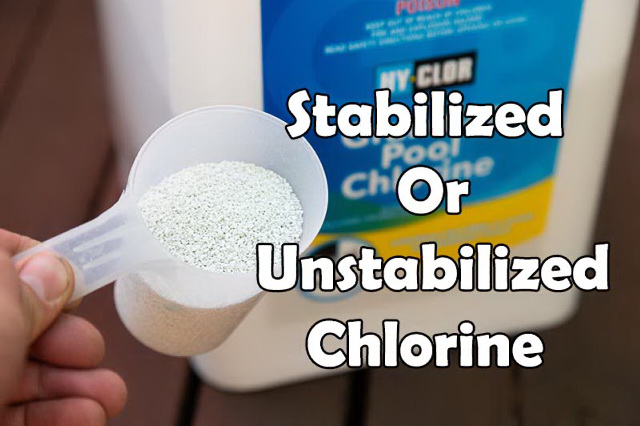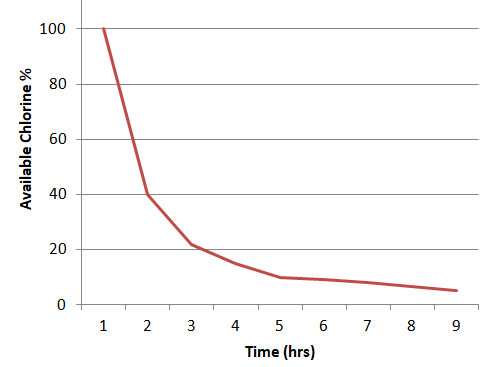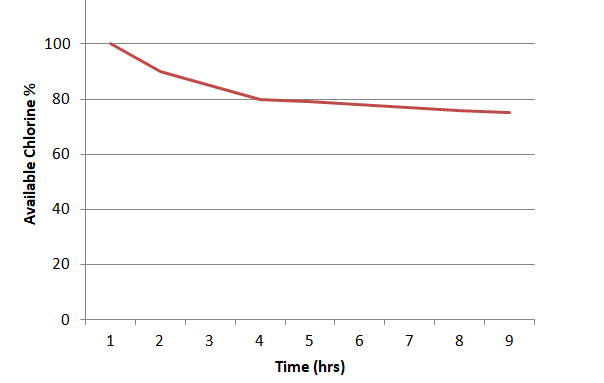For pool owners chlorinating their pools, it can be hard to know if stabilized or unstabilized chlorine should be used. It is an important decision and choosing the wrong one for your situation can lead to more headaches than solutions.
Read on to find out if you should be using stabilized or unstabilized chlorine in your pool.
For outdoor pools, stabilized chlorine is the best way to sanitize your pool. Unlike unstabilized chlorine, stabilized chlorine doesn’t break down quickly in the sun and will last days before you need to add more. For indoor pools and shocking, unstabilized chlorine is best so that you don’t unnecessarily raise your cyanuric acid (CYA or stabilizer) levels in your pool.
There are many factors that may require you to switch from stabilized chlorine to unstabilized chlorine or visa versa. We’ll dive more into depth on what those situations might be and why you may need to consider a switch at some points.

Article Contents
What is Stabilized Chlorine
Stabilized chlorine is a type of chlorine for your pool that contains a stabilizer, such as cyanuric acid. The stabilizer in the chlorine creates a compound that does not break down in sunlight and will last longer in your pool.
A pool that is exposed to a lot of sunlight will benefit from stabilized chlorine. When sunlight meets unstabilized chlorine, it breaks down the chlorine within hours and requires you to replace the chlorine more often.
Stabilized chlorine allows you to change the chlorine in your pool less frequently because it lasts longer in the sun.
Types of Stabilized Chlorine
Types of stabilized chlorine include:
- Trichlor
- Dichlor
Trichlor is commonly found in tablet form and is great for everyday use in outdoor pools to maintain free chlorine levels. Trichlor is a slow dissolving tablet that contains cyanuric acid (stabilizer).
Dichlor is another form of stabilized chlorine that contains cyanuric acid. Dichlor contains more stabilizer (cyanuric acid) than trichlor and is typically found in granular form and dissolves quickly.
Dichlor is great for quick boosts to both chlorine and cyanuric acid, if they are low. Adding dichlor to a pool with higher cyanuric acids (CYA) will cause the CYA levels to get too high, therefore it is nor great for everyday chlorination.
Check out this chart below for common brands that make stabilized chlorine.
Common Brands of Stabilized Chlorine
| Clorox 3″ Trichlor Chlorinating Tablets | ProTeam Dichlor Granules (stabilized) |
| HTH 3″ Chlorinating Tablets | Rx Clear Sodium Stabilized Granular Chlorine |
| Pool Mate 3-Inch Stabilized Chlorine Tablets | SpaGuard Sodium dichloro-s-triazinetrione Powder |
What is Unstabilized Chlorine
Unlike stabilized chlorine, unstabilized chlorine contains zero additives, meaning there is no added stabilizer to the chlorine. Unstabilized chlorine is simply chemical chlorine.
Since there is no stabilizer in unstabilized chlorine, when it is exposed to sunlight, the chlorine will break down as it reacts to the UV rays of the sun and become far less effective.
If you have an outdoor pool, using unstabilized chlorine without also adding a separate stabilizer is not recommended because the disinfecting properties of the chlorine will degrade quickly in the sun, which means you have to add more chlorine more often and this can become pricey.
For indoor pools, you do not need to stabilize the chlorine. Shocking your pool is also best done with unstabilized chlorine because the CYA levels will not rise.
Further Reading: Should You Use Stabilizer for Indoor Pools?
For times that your pool is seeing higher use than normal stabilizer levels, unstabilized chlorine is the way to go. You’ll raise the chlorine levels without further increasing the stabilizer levels. And because there is stabilizer already in the water, the chlorine will still be protected.
Types of Unstabilized Chlorine
Unstabilized chlorine is most commonly found as:
- Liquid chlorine
- Lithium hypochlorite
Common brands that produce unstabilized chlorine include:
- Champion 12.5% Strength Liquid Chlorine
- Rx Clear Calcium Hypochlorite Shock
- HTH Calcium Hypochlorite Shock
Liquid chlorine, also known as sodium hypochlorite, is found in, you guessed it, liquid form. Liquid chlorine contains about 10-12.5% available chlorine and one gallon provides 12.5ppm for every 10,000 gallons of water.
Calcium Hypochlorite (Cal Hypo) is typically found in granular form. Cal hypo contains about 40-80% available chlorine and is most commonly found in pool shock. In addition to chlorinating, for every 1 ppm of free chlorine, cal hypo will also add 0.8 ppm of calcium to your pool, so keep that in mind. High calcium levels aren’t good for your pool water.
Lithium hypochlorite is found in granular form and dissolves right into the pool water. The available chlorine is about 55% and makes for a great pool shock or in cases when super chlorination is needed.
Stabilized Vs Unstabilized Chlorine
While both stabilized chlorine and unstabilized chlorine are both used for chlorinating and disinfecting your pool, they differ in how they achieve that task.
Stabilized chlorine contains cyanuric acid to prevent the sun from breaking down the compound, whereas unstabilized chlorine does not contain the compound and the sun’s UV rays can break it down fairly quickly.
When using unstabilized chlorine, it will take only hours for the sun’s UV rays to break down the chlorine and drastically lower the free chlorine levels. Stabilized chlorine is not impacted by the sun’s UV rays as much as unstabilized chlorine and it will take days before the sun’s UV rays drastically lower the free chlorine levels.
Further Reading: Liquid Chlorine Vs Tablets – What’s Better for Your Pool?
Check out this chart for all the key differences of stabilized and unstabilized chlorine.
| Stabilized Chlorine | Unstabilized Chlorine |
|---|---|
| Used for outdoor pool disinfecting. No additional added stabilizer required. | Used for indoor pool disinfecting or shock. Can use for outdoor pools but they must already have stabilizer in the water. |
| Contains cyanuric acid (stabilizer) | Contains no stabilizer (cyanuric acid) |
| More Expensive | Cheaper |
| Trichlor – $60-$80 per bucket | Liquid Chlorine – $20-$30 per gallon |
| Dichlor – $30-$50 – per pound | Cal Hypo – $15 for 1 pound |
| Resistant to sun’s UV rays | Degrades quickly in the sun |
When there is too much stabilizer in your pool, the chlorine will become less effective. On the other hand, when there is not enough stabilizer, the sun will degrade the chlorine rapidly.
The chart below recommends how much free chlorine is needed to effectively sanitize your pool based on the levels of cyanuric acid in the pool.
| Cyanuric Acid (Stabilizer) | Free Chlorine Required |
|---|---|
| 20 | 2 |
| 30 | 2.5 |
| 40 | 3 |
| 50 | 4 |
| 60 | 4.5 |
| 70 | 5 |
| 80 | 6 |
| 90 | 7 |
| 100 | 8 |
How Long Does Stabilized Chlorine Last Compared to Unstabilized?
When chlorinating an outdoor pool, stabilized chlorine will last much longer than unstabilized chlorine.
The graph below shows chlorine degradation without stabilizer when it is exposed to the sun’s UV rays.

As unstabilized chlorine is exposed to the sun, the available chlorine levels drop drastically in just a few hours. Over the course of 9 hours, unstabilized chlorine will go from 100% available chlorine to almost 0%.
This means that if unstabilized chlorine is used in your outdoor pool when there is no stabilizer present in the water, your chlorine levels could be back to 0 by the end of the day. Replenishing your chlorine levels every day with unstabilized chlorine will become costly and time consuming.
The graph below shows chlorine degradation with stabilizer when exposed to the sun’s UV rays.

As you can see, the degradation of the chlorine when there is stabilizer present in the water is much slower over the course of 9 hours as compared to unstabilized chlorine. When exposed to the sun’s UV rays for 9 hours, there is still over 75% available chlorine.
With stabilized chlorine it would take about four days for the available chlorine to reach 0% compared to just 9 hours for unstabilized chlorine. This means stabilized chlorine lasts more than four times as long as unstabilized chlorine when exposed to the sun.
Is Stabilized Chlorine Bad?
Stabilized chlorine is not a bad thing, but only when it’s needed. In the past, when stabilized chlorine didn’t exist, pool owners would need to add chlorine every single day. Stabilized chlorine offers much easier (and cheaper!) pool maintenance for pool owners.
With that being said, chlorine does become less effective when stabilizer is present. It’s a tricky game and the fun part is, you get to play the role of the mad scientist when trying to find the perfect balance for your pool.
If your pool has higher levels of cyanuric acid, such as 100 ppm, then the required amount of chlorine is going to skyrocket. If you’re adding stabilized chlorine to a pool with already high CYA levels, you’re going to be battling against yourself in an endless loop of adding chlorine.
If you keep cyanuric acid in the range of 30ppm-60ppm, your chlorine will work as it needs to sanitize your poll effectively.
On the other hand, liquid chlorine (non-stabilized chlorine) has the least “side effects” in your pool. Liquid chlorine leaves no staining or residue in your pool. Lastly, because it has no stabilizer and is strictly chlorine, other chemicals in your pool won’t be impacted as they are with stabilized chlorine or even cal hypo.
In addition, unlike granular options, liquid chlorine can be refilled and is much less costly.
How to Decide If You Need Stabilized or Unstabilized Chlorine
So, now you know all the ins and outs of stabilized versus unstabilized chlorine, but which one should you choose for your pool?
When chlorinating outdoor pools, stabilized chlorine is going to be best. You will need the stabilizer to protect the chlorine from degrading in the sun. If you are chlorinating an indoor pool, cyanuric acid won’t be needed to protect the pool from the sun’s UV rays, so unstabilized chlorine would be best.
In outdoor pools, if the CYA levels are already high, adding stabilized chlorine is going to raise them even more and make your chlorine ineffective and costly and therefore, unstabilized chlorine is best.
For outdoor pools with low or normal CYA levels, stabilized chlorine will work best to most effectively chlorinate the pool.
When it comes to convenience, stabilized chlorine is going to degrade four times slower in the sun when compared to unstabilized chlorine. This is great for daily chlorination and not having to manually add chlorine each day.
If you are looking to shock your pool, an unstabilized chlorine is going to be best so that you don’t skyrocket the CYA levels in your pool.
Is Pool Shock Stabilized Chlorine?
Pool shock does not contain any cyanuric acid which means that it is unstabilized. Because pool shock contains no cyanuric acid, it does not stay in your pool longer than it should.
If you shocked your pool with stabilized chlorine, it would take far too long to return to safe swimming levels. However, in a pinch, if CYA levels are drastically low, dichlor can be used as a shock to both super chlorinate and raise your CYA levels in your pool, if needed.
Final Thoughts
You are now equipped with all the information you need on choosing stabilized or unstabilized chlorine!
With all this new knowledge, you know there isn’t a “one size fits all” solution and that sometimes you may need to switch your chlorination method based on other variables, such as your CYA levels.
This information will save you a lot of time battling against yourself and should make you confident that you’ll continue keeping your pool nice and clear!
Related Reading: Which Chlorine to Use for Inground Pools?

